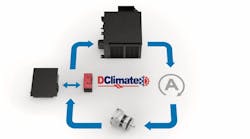This is Part One of a five-part story.
Though the rules don’t come right out and order it, the EPA’s looming emissions standards for light-, medium-, and heavy-duty standards starting with Model Year 2027 commercial vehicles will force fleets to increase their number of ZEVS, which encompass battery electric vehicles (BEVs) and fuel cell electric vehicles (FCEVs). The LD/MD standards do, however, include this caveat: “EPA finds that it would be technologically feasible to meet these standards without additional zero-emission vehicles beyond the volumes already sold today.”
“Technologically feasible” is code for “possible but not practical.”
In reality, fleets and maintenance providers are going to have to learn a lot about ZEVs in a short amount of time, as the emissions rules really ramp up in 2032. Now, we’d wager that the majority of fleets have little to no real-world experience with commercial ZEVs. And test drives don’t count.
We’re confident in this for two reasons. First, the only commercially available fuel cell truck, the Nikola Tre FCEV, entered into a few fleets only this year. Second, while several large fleets have rolled out a sizable number of BEVs, there are 3.5 million fleets in the U.S., according to NTEA. As of June 2023, CALSTART counted 17,734 zero-emission trucks deployed total. In the last year, that number has certainly grown by quite a bit—Amazon alone has more than 13,500 electric delivery vans in the U.S., with a target of 100,000 by 2030—but they still count as one fleet, and the fact remains: millions of fleets don’t truly know what they’re in for.
There are some that do have experience, though. And we want to share their stories in the following series to better prepare the industry for both the positives and negatives in this zero-emissions sum game.
Tesla: Choice of a new generation?
ZEVs are far from new. Henry Ford famously bought his wife Clara a 1914 Model 47 Detroit Electric, and an electric Model T would have been a thing if Ford engineers could get the nickel-iron battery developed by Thomas Edison to work more reliably. But they didn’t, and internal combustion dominated the 20th Century, save for the one 1981 episode of Mr. Rogers’ Neighborhood featuring an electric car so boxy and crude it looked like a young viewer designed it with crayons.
Then, in 2012, a very stylish EV called the Model S, made by Tesla Inc., rose to prominence, becoming the world’s best-selling plug-in for 2015 and 2016. The company’s CEO Elon Musk, in some ways a spiritual successor to Henry Ford, saw electrifying transportation as a primary mover to improve the Earth’s long-term viability to support humans (with colonizing Mars as a backup plan). As tractor-trailers gained a reputation as the biggest emissions offenders (though they have cleaned up their act considerably since 2000), in 2017 Musk unveiled the Tesla Semi, an electric truck that would revolutionize the industry. Musk made bold claims that the Semi would get up to a 500-mile range, go 0 to 60 mph in under 20 seconds fully loaded, and cost $150,000. The boldest statement was pinpointing a production start date of 2019.
At the time, Daimler AG, the leading manufacturer of trucks, was working on Class 8s called the Mercedes-Benz eActros that had a quarter of the purported range of the Tesla Semi. Current Daimler Truck chairman Martin Daum alluded at the time that the company was working on trucks purpose-built for the long haul—not in terms of duty cycle but in staying power.
“Trucks have to run for 1.5 million miles and then there’s a used-truck buyer too after that,” Daum said in 2018, responding to the hype around the Semi. “We don’t know for sure how batteries for trucks will react after being in use for four to five years—it’s very complex.”
He doubted Tesla could make good on the 2019 date but did say, “If Tesla really delivers on this promise, we’ll obviously buy two trucks—one to take apart and one to test because if that happens, something has passed us by.”
It appeared the truck OEMs would all pass Tesla by, just as Tesla raced ahead of the Detroit Big Three in the passenger EV market. The Volvo VNR Electric, Kenworth T680E, and Mack LR Electric refuse truck all went into production in 2021. By the next May, DTNA’s Freightliner eCascadia entered production after 1 million test miles.
The Tesla Semi finally entered limited production in late 2022, with PepsiCo as a first customer. When PepsiCo’s Sacramento terminal participated in Run on Less – Electric Depot, a project orchestrated by the North American Council on Freight Efficiency last year, the public was finally able to see if reality met expectations. The data collection at 10 different terminals, eight in California, would benchmark where various BEVs were in terms of fleet productivity relative to existing charging infrastructure at the terminals.
The 18-day study indicated PepsiCo’s three Tesla Semis might indeed warrant a teardown by competitors. NACFE recorded one of Pepsi’s Semis traveling 410 miles on a single charge and 1,076 miles over a full day. For 60% of those miles, the Semi’s GVWR was above 70,000 lbs. To facilitate the speedy recharge, Pepsi used Tesla’s 750-kW Megacharger. Telsa said the ultra-fast system can “recover 70% of range in 30 minutes.”
At the 2024 ACT Expo, Dan Priestley, Tesla’s sr. manager of Semi truck engineering, said, “Megawatt-level fast charging is available, reliable, safe, and unlocks the next level of economics. What this does is it unlocks operational equivalence between diesel and electric.”
He also noted that after 3.5 million test miles, the Semi has shown “uptime greater than 95%, and this includes both preventative and unscheduled maintenance.” Priestley also said the Semi has operated at -35 degrees F in Alaska and 120 degrees F in Death Valley.
Tesla said it has leveraged its years servicing passenger EVs into maintaining and repairing its commercial BEVs. “We do our own training, and we developed physical as well as virtual information to allow the technicians to do their job effectively and ultimately get the product back into the world earning money as quickly as possible,” Priestley said.
Full production is set for 2026 at the Nevada Gigafactory, with a future capacity of 50,000 Semis annually. Still, what Daum noted six years ago on batteries should still echo in the minds of fleet maintenance leaders.
“The big question is if you can really make the battery reliable over the lifetime of the battery,” noted Jeff Seger, clean energy consultant at NACFE, who acknowledged the Semi was the “very best” the industry has right now in terms of ZEVs.
Seger, not privy to any of Tesla’s internal testing, not sure these powerful batteries can last eight to 10 years, asked, “if you’re fast charging all the time, what’s the degradation of the battery?”
According to a study of 12,500 Telsa consumer EVs by Recurrent, frequently using a 250-kw Tesla Supercharger did not adversely affect range.
Recurrent surmised that “the robust thermal, voltage, and battery management systems that EV makers have invested in do protect their batteries from damage with routine fast-charger use.”





